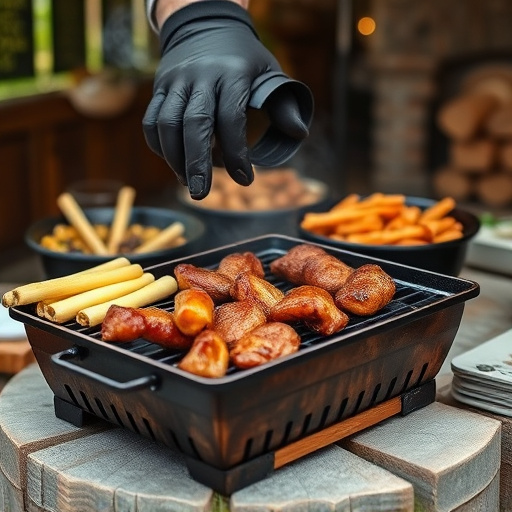The captivating smoky flavor in BBQ pork ribs arises from chemical reactions during wood burning, creating volatile organic compounds (VOCs) that blend with heat and moisture for a unique taste. Charcoal provides intense, pure smoke, while wood chips offer diverse flavors. For the perfect recipe, choose hardwoods like hickory, oak, or mesquite for classic smokey notes, adapting wood selection to rib cuts. Master the art of smoking by setting up your smoker, maintaining 225°F-250°F (107°C-121°C), and regularly misting with apple juice or beer. Combine spices, wood chips, and slow cooking over indirect heat for tender, flavorful ribs, finishing with a sear at high heat to lock in tastes.
Unleash the mouthwatering allure of smoked BBQ pork ribs with the secret ingredient—wood chips or charcoal. This article delves into the art and science behind crafting that distinctive smoky flavor, guiding you from choosing the perfect wood chips to mastering the step-by-step smoker setup and cooking techniques. Discover tips for achieving a tender, juicy rib recipe that will have your taste buds dancing with delight.
- Understanding Smoky Flavor: The Science Behind Wood Chips and Charcoal
- Choosing the Right Wood Chips for Your BBQ Pork Ribs
- Setting Up Your Smoker: A Step-by-Step Guide
- The Art of Smoking Pork Ribs: Techniques and Tips
- Mastering the BBQ Pork Rib Recipe: From Start to Finish
Understanding Smoky Flavor: The Science Behind Wood Chips and Charcoal

Smoky flavor is a culinary delight that transports us to cozy barbecue gatherings and mouthwatering dishes like a BBQ pork rib recipe. But what exactly makes wood chips and charcoal so enchanting when it comes to imparting this distinctive taste? The science behind it lies in the complex chemical reactions that occur during the burning process. When wood or charcoal is heated, volatile organic compounds (VOCs) are released, carrying with them the unique aromas and flavors associated with different types of wood. These VOCs mix with heat and moisture to create a smoky profile that enhances the overall taste experience.
In the case of BBQ pork ribs, the slow cooking process over indirect heat allows these smoky compounds to deeply infuse the meat, resulting in a savory, aromatic dish. Charcoal, known for its uniform burning and intense heat, is particularly sought-after for grilling due to its ability to produce a pure, concentrated smoke flavor. Wood chips, on the other hand, offer a broader range of flavors depending on the type of wood used, from hickory and mesquite to apple and cherry, each bringing a distinct character to whatever dish they’re paired with.
Choosing the Right Wood Chips for Your BBQ Pork Ribs
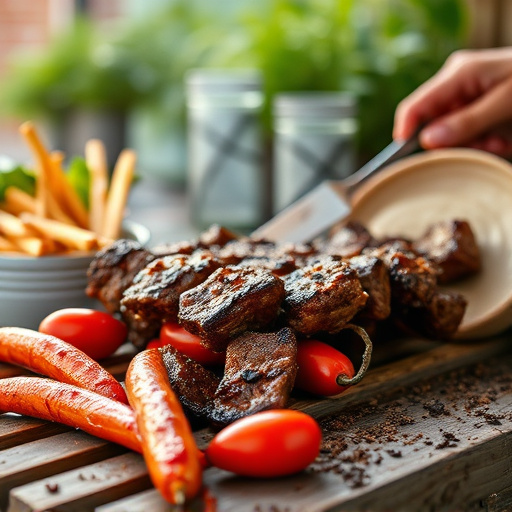
When crafting a mouthwatering BBQ pork ribs recipe, selecting the perfect wood chips is an art in itself. The key lies in understanding how different woods impart unique flavors to your meat. For a classic, smoky taste, opt for hardwoods like hickory, oak, or mesquite. These woods offer a robust and distinct flavor profile that is highly sought after in BBQ circles. Hickory, in particular, is a favorite among rib enthusiasts due to its rich, intense smoke.
Consider the type of pork ribs you’re preparing and adjust your chip choice accordingly. For baby back ribs, a milder smoke from applewood or cherrywood chips can complement their tender texture. In contrast, spare rib cuts benefit from the stronger flavor of mesquite or oak chips. Experimenting with different wood combinations can also create intriguing flavor variations, allowing you to craft a truly signature BBQ pork ribs recipe.
Setting Up Your Smoker: A Step-by-Step Guide
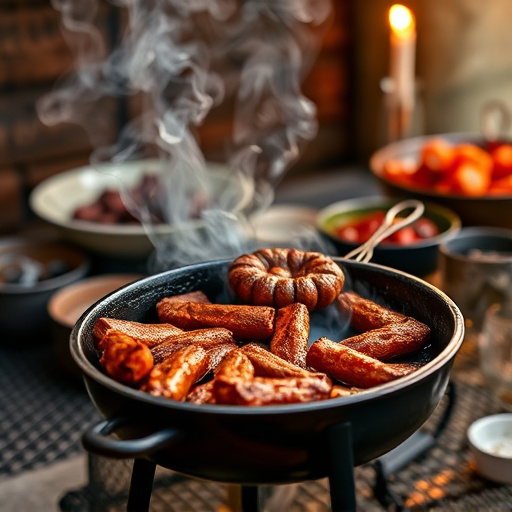
Setting up your smoker for that perfect BBQ Pork Rib Recipe is an art in itself. Start by choosing the right smoker, whether it’s a pellet or charcoal model, tailored to your cooking style and preference. Next, fuel your smoker with either wood chips or charcoal. For a smoky, mouthwatering BBQ Pork Rib experience, oak, hickory, or mesquite chips are popular choices that impart a rich flavor. If using charcoal, prepare a bed of briquettes, lighting them evenly for consistent heat distribution. The key is to maintain a low and slow cook, allowing the smoke to gently envelop the ribs, infusing them with its distinct aroma.
Once your smoker is fueled, place the ribs on the grill racks, ensuring even contact with the heat source. Close the smoker lid, locking in the smoke and heat. Monitor the temperature regularly, adjusting as needed to maintain a consistent cook. The magic happens as the smoke slowly cooks the ribs, tenderizing the meat and infusing it with that coveted smoky flavor, perfect for your BBQ Pork Rib Recipe.
The Art of Smoking Pork Ribs: Techniques and Tips
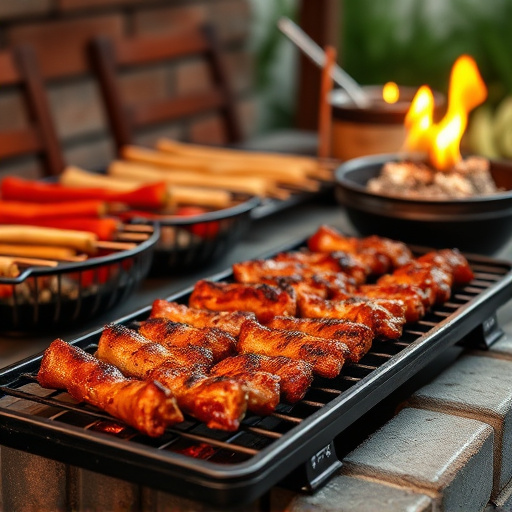
Smoking pork ribs is an art that takes time, patience, and a deep understanding of the smoke process. When it comes to enhancing the flavor of your BBQ pork rib recipe, wood chips and charcoal play a pivotal role. The subtle yet profound smoky aroma and taste are what set apart a good rib from a great one.
To master this technique, start by choosing the right type of wood chips—hickory, mesquite, or applewood are popular choices—and ensuring your grill or smoker is at the ideal temperature range between 225°F to 250°F (107°C to 121°C). For a BBQ pork rib recipe, a slow and steady smoke process allows the meat to tenderize and absorb the rich flavors from the wood. Use a spray bottle with apple juice or beer to keep the ribs moist during the long hours of smoking, preventing them from drying out.
Mastering the BBQ Pork Rib Recipe: From Start to Finish
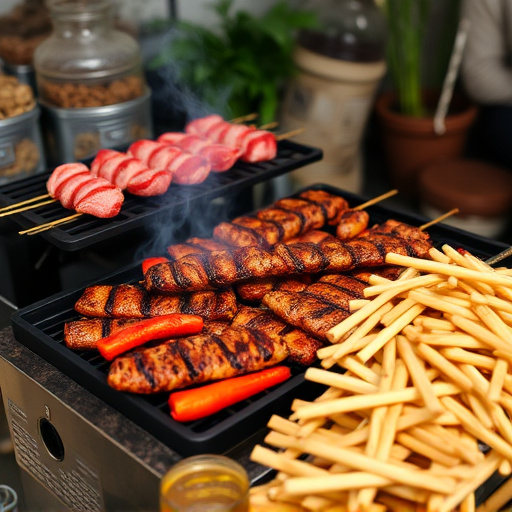
Mastering the perfect BBQ Pork Ribs is an art, and with the right techniques and ingredients, you can create a mouthwatering dish that’s sure to impress. The key lies in using wood chips or charcoal to impart a smoky flavor that enhances the rich, tender meat. Start by preparing your ribs: rub them down with a blend of spices like paprika, brown sugar, salt, and pepper to create a delicious crust. Then, fire up your grill with a mix of wood chips—hickory, mesquite, or oak work wonders—to achieve that signature smoky taste.
Slow-cook the ribs over indirect heat until the meat becomes tender and starts to pull away from the bone. This process takes time, but it ensures the ribs stay juicy and flavorful. Once cooked, brush on your favorite BBQ sauce for an extra layer of richness before finishing them off with a sear on high heat to caramelize the sauce and seal in the flavors. The result? Tender, smoky BBQ Pork Ribs that are sure to become a family favorite.
